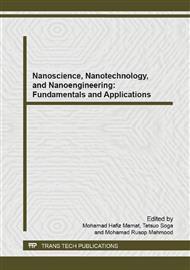p.171
p.176
p.181
p.186
p.191
p.195
p.200
p.205
p.210
Temperature Induced Formation of Goethite from Magnetite
Abstract:
Over the past few decades, magnetite nanoparticle has been profusely because of their wide range of applications. The co-precipitation method is the simplest and suitable method for the preparation of this nanoparticle. It goes through several reaction steps for the formation of various phases of magnetic nanoparticles. Goethite (FeO(OH)), is one of the intermediates, and it drastically suppressed with the magnetic properties of the Fe oxide phase. In our study, it was shown that at 30°C temperature pure magnetic nanoparticles is formed. But when precipitation temperature is increase to 80°C, goethite is also present with the magnetite nanoparticle. Hence, it is deduced that precipitation temperature plays a significant role in accelerating goethite phase formation when synthesising magnetite nanoparticle by this precipitation method. Data obtained from Raman spectroscopy and XRD supported the above observation.
Info:
Periodical:
Pages:
191-194
Citation:
Online since:
June 2015
Authors:
Price:
Сopyright:
© 2015 Trans Tech Publications Ltd. All Rights Reserved
Share:
Citation:


